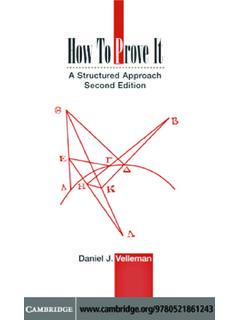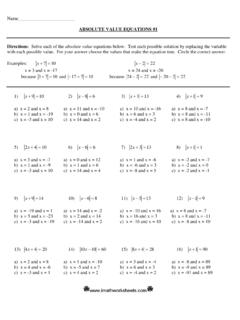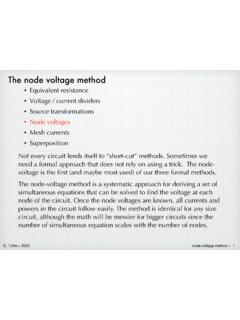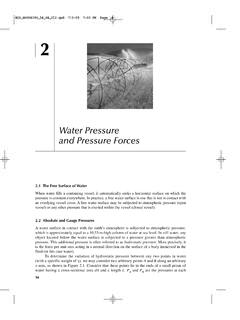Transcription of Chapter 1 Governing Equations of Fluid Flow and Heat Transfer
1 ME 582 Finite Element Analysis in Thermofluids Dr. C neyt Sert 1-1 Chapter 1 Governing Equations of Fluid Flow and Heat Transfer Following fundamental laws can be used to derive Governing differential Equations that are solved in a Computational Fluid Dynamics (CFD) study [1] conservation of mass conservation of linear momentum (Newton's second law) conservation of energy (First law of thermodynamics) In this course we ll consider the motion of single phase fluids, either liquid or gas, and we'll treat them as continuum. The three primary unknowns that can be obtained by solving these Equations are (actually there are five scalar unknowns if we count the three velocity components separately) velocity vector pressure temperature But in the Governing Equations that we solve numerically following four additional variables appear density enthalpy (or internal energy ) viscosity thermal conductivity Pressure and temperature can be treated as two independent thermodynamic variables that define the equilibrium state of the Fluid .
2 Four additional variables listed above are determined in terms of pressure and temperature using tables, charts or additional Equations . However, for many problems it is possible to consider , and to be constants and to be proportional to with the proportionally constant being the specific heat . Due to different mathematical characters of Governing Equations for compressible and incompressible flows, CFD codes are usually written for only one of them. It is not common to find a code that can effectively and accurately work in both compressible and incompressible flow regimes. In the following two sections we'll provide differential forms of the Governing Equations used to study compressible and incompressible flows. Conservation of Mass (Continuity Equation) ( ) or equally ( ) ME 582 Finite Element Analysis in Thermofluids Dr.
3 C neyt Sert 1-2 These Equations are known to be the conservative and non-conservative forms of mass conservation, respectively. Conservation forms of Equations can be obtained by applying the underlying physical principle (mass conservation in this case) to a Fluid element fixed in space. Non-conservative forms are obtained by considering Fluid elements moving in the flow field. The link between these two Equations can be established using the following general equation that relates spatial and material descriptions of Fluid flow The term on the left hand side of this equation is known as the material derivative of property . First term on the right hand side is the partial time derivative or local derivative.
4 Last term is called the convective derivative of . Conservation of Linear Momentum Equation for the conservation of linear momentum is also known as the Navier-Stokes equation (In CFD literature the term Navier-Stokes is usually used to include both momentum and continuity Equations , and even energy equation sometimes). It is possible to write it in many different forms. One possibility is In order to be able to use an Eulerian description, material derivative at the left hand side, which is the acceleration vector, can be replaced with the sum of local and convective accelerations to get [ ] where is the body force per unit mass.
5 If the weight of the Fluid is the only body force we can replace with the gravitational acceleration vector . of the above equation is the viscous stress tensor. For Newtonian fluids viscous stresses only depend on the velocity gradient and the dependency is linear. Also it is known that needs to be symmetric in order to satisfy the conservation of angular momentum. For a Newtonian Fluid the relation between and the velocity components is as follows ( ) ( ) where denote mutually perpendicular coordinate directions. is the dynamic viscosity and is known as the coefficient of bulk viscosity. It is related to the viscosity through the Stokes hypothesis and using this hypothesis viscous stress tensor becomes ( ( ) ) ME 582 Finite Element Analysis in Thermofluids Dr.
6 C neyt Sert 1-3 where is the Kronecker-Delta operator which is equal to 1 if and it is zero otherwise. Navier-Stokes equation given in Eqn ( ) is said to be in non-conservative form. A mathematically equivalent conservative form, given below, can also be derived by using the continuity equation and necessary vector identities ( ) ( ) where is the tensor product of the velocity vector with itself, as given below [ ] divergence of which is the following vector ( ) { }[ ] { } For compressible flow simulations it is quite common to see the use of Euler's equation instead of Navier-Stokes.
7 Euler's equation is obtained by dropping the viscous term of the Navier-Stokes equation, which makes it a first order PDE. It is frequently used to obtain the pressure distribution of high speed (and therefore high ) aerodynamic flows around/inside flying bodies where viscous affects are squeezed inside very thin boundary layers. However, one needs to be careful in using the Euler's equation since it can not predict flow fields with separation and circulation zones successfully. Conservation of Energy Energy equation can be written in many different ways, such as the one given below [ ( )] where is the specific enthalpy which is related to specific internal energy as . is the absolute temperature and is the dissipation function representing the work done against viscous forces, which is irreversibly converted into internal energy.
8 It is defined as Pressure term on the right hand side of equation ( ) is usually neglected. To derive this energy equation we considered that the conduction heat Transfer is governed by Fourier s law with being the thermal conductivity of the Fluid . Also note that radiative heat Transfer and internal heat generation due to a possible chemical or nuclear reaction are neglected. ME 582 Finite Element Analysis in Thermofluids Dr. C neyt Sert 1-4 Equation of state: For compressible flows the relation between density, pressure and temperature is given by a special equation called equation of state. The most commonly used one is the following ideal gas relation where is the gas constant, being equal to for air.
9 For an ideal gas it is also possible to use the following relations to relate enthalpy and internal energy to temperature so that energy equation can be written as temperature being the only unknown. In general all three conservation Equations (conservation of mass, momentum and energy) are coupled and they need to be solved simultaneously. Overall we have 6 scalar unknowns (density, pressure, 3 velocity components and temperature) which can be obtained by solving 6 scalar Equations (conservation of mass, 3 components of conservation of momentum, conservation of energy and equation of state). Incompressible Flows For incompressible flows density has a known constant value , it is no longer an unknown.
10 Also for an incompressible Fluid it is not possible to talk about an equation of state. Conservation of Mass: For constant density, Eqn ( ) simplifies to which means that the velocity field of an incompressible flow should be divergence free, which is known as the divergence free constraint in CFD literature. Note that there is no time derivative in the continuity equation even for unsteady flows, which is one of the reasons that make numerical solution of incompressible flows difficult. Conservation of Linear Momentum: For incompressible flows second term of the viscous stress tensor given in Eqn ( ) is zero due to the incompressibility constraint given in Eqn ( ). Considering this simplification together with viscosity being constant, Eqn ( ) can be written as follows [ ] Dividing the equation by density we get the following form of the Navier-Stokes equation where is the constant kinematic viscosity.


















